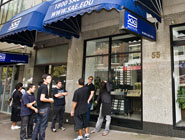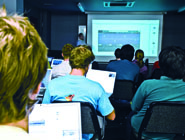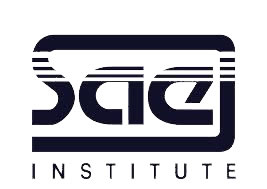Case Study
SAE
School of Audio Engineering
The scope of SAE’s educational programme has expanded far beyond its original focus on the delivery of vocationally oriented audio engineering training to encompass film making, web design, multimedia, games design and 3D animation. In addition international artists and musicians make use of its world-class commercial production facilities.
The fast and reliable delivery of the masses of data generated by both the training and commercial production operations is the responsibility of Technology Systems Manager Phil Dohna who oversees an enterprise network linking the production facilities and the 6 Australian campuses that serve 3,000 students.
Configured as a single infrastructure resource the SAE national network relies heavily on MikroTik technology that has, for over 3 years, been supplied and supported by DuxTel.
In a central data center at the network core, high performance rack servers with gigabit network cards run MikroTik RouterOS to provide enterprise level performance more than four times higher than standard RouterBOARD devices. These enterprise class routers manage the fibre backbone traffic between the 6 Australian campuses.
Each campus has a high performance MikroTik system at its gateway while wireless connectivity throughout each campus is provided using a range of MikroTik RouterBOARD access points.
SAE’s reliance on MikroTik technology to run this mission critical high-performance infrastructure is immediately apparent upon entering Phil’s South Melbourne office where an entire wall is illuminated by a pair of data projectors devoted to MikroTik’s celebrated network visualisation and management application The Dude.
At a glance Phil and his team can monitor around 100 RouterOS servers and RouterBOARDs and many third-party servers and applications. “Using The Dude we can spot problems instantly and often address problems before they impact users. The ticketing and SMS is very powerful” says Phil. Not content with merely confirming that a service is running on a port Phil uses the Dude’s own scripting language to proactively monitor the actual output of a server running, for example, a DNS or other directory service. Using SNMP, Phil says that he can “monitor temperature, humidity, power, door controls and execute RAID shutdowns in the event of air-conditioning failures” which comes in handy at the hot and humid SAE Byron Bay campus and administrative headquarters.
Well over half of The Institute’s students are from overseas and they bring with them high expectations of network performance. Internet connectivity at Byron Bay for example has grown from dialup lines through to half-a-dozen aggregated and load-balanced ADSL1 lines through to ADSL2+ from the moment it became available in the thriving northern NSW tourist and lifestyle mecca.
The commercial production facilities, administrative HQ, campus and associated student residential clusters generate more than 600GB of download per week from more than 200 independent network clients. The burden of handling this traffic rests capably on the shoulders of 18 RouterBOARDs, some of which terminate wireless links to residential clusters up to 15Km away from the main site.
“We’ve used virtually early model of MikroTik hardware ever produced and have never had a hardware failure. One of the electronic engineers from our subsidiary Neve opened up a RouterBOARD and was impressed to find some of the same premium components we use in our line of mixing consoles – build quality is important in places like Byron Bay where it’s hot, humid and the air is salty and corrosive.”
Crucial to Phil’s success in providing this level of support is his long-term relationship with DuxTel. “We wouldn’t be where are now”, says Phil. “DuxTel sorts out issues straight away and are a source of inspiration and knowledge. I can run ideas past Mike and he might offer a different perspective – suggesting an alternative approach.”


Partners

From modest beginnings in Sydney in 1974 with nothing more than a 4 track reel-to-reel tape recorder and a 12 channel mixing desk, the School of Audio Engineering has grown into a global creative media technology powerhouse with 50 international campuses in 20 countries.

 Download as pdf
Download as pdf